
Lady Bowen Hospital is a heritage-listed former maternity hospital at 497-535 Wickham Terrace, Spring Hill, City of Brisbane, Queensland, Australia. It was designed by John H. Buckeridge and built from 1889 to 1890 by John Quinn. It was also known as Brisbane Lying-In Hospital, Lady Bowen Hostel, and Anzac House & Club. It was added to the Queensland Heritage Register on 23 April 1999.
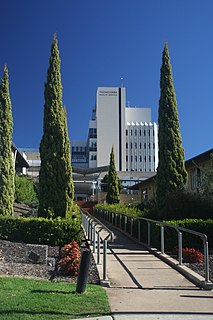
Toowoomba Hospital is a heritage-listed hospital at Pechey Street, Toowoomba, Toowoomba Region, Queensland, Australia. It was built from c. 1880 to c. 1927. It is also known as Toowoomba Base Hospital. It was added to the Queensland Heritage Register on 28 July 2000.

Main Beach Pavilion and Southport Surf Lifesaving Club are heritage-listed beach buildings off Macarthur Parade, Main Beach, Queensland, Australia. The Main Beach Pavilion was designed by Thomas Ramsay Hall and Lionel Blythewood Phillips of the architectural firm Hall and Phillips and built in 1934 for the Southport Town Council. The Surf Lifesaving Club was also designed by Hall and Phillips and built adjacent in 1936 for the club. They were added to the Queensland Heritage Register on 1 March 1995.

Rosalie Community Kindergarten and Preschool is a heritage-listed kindergarten at 57 Elizabeth Street, Paddington, City of Brisbane, Queensland, Australia. It was designed by Arnold Edward Brooks and built in 1935 by Ralph Alexander Lind. It is also known as Rosalie Kindergarten and The Little Citizens Free Kindergarten. It was added to the Queensland Heritage Register on 27 September 2002.
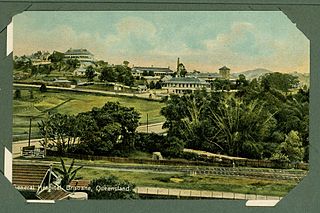
Brisbane General Hospital Precinct is a heritage-listed hospital precinct at 40 Bowen Bridge Road, Herston, City of Brisbane, Queensland, Australia. It was built from 1875 to 1941. It includes six historic buildings associated with the Royal Brisbane and Women's Hospital and the former Royal Children's Hospital, as well as aspects of their grounds and landscaping. It was added to the Queensland Heritage Register on 28 March 2003. A number of buildings in the precinct, in particular the Lady Lamington Nurses Home, will be redeveloped as part of the Herston Quarter development.

Maryborough Base Hospital is a heritage-listed hospital at Walker Street, Maryborough, Fraser Coast Region, Queensland, Australia. It was designed by Queensland Colonial Architect John James Clark and built from 1887 by Robert Taylor. It is also known as Maryborough General Hospital. It was added to the Queensland Heritage Register on 2 February 1998.

Rockhampton Base Hospital is an historic hospital at Canning Street, The Range, Rockhampton, Rockhampton Region, Queensland, Australia. It was established in 1867. The hospital's medical superintendent's residence and Therapies Block were added to the Queensland Heritage Register on 21 November 1997.

Kenmore House is a heritage-listed mansion at 31 Ward Street, The Range, Rockhampton, Rockhampton Region, Queensland, Australia. The design is attributed to James Flint and it was built from c. 1894 onwards. It is also known as Mater Misericordiae Hospital, Pinehurst and The Mansion. It was added to the Queensland Heritage Register on 21 October 1992.

St Paul's Anglican Church is a heritage-listed church at 8 Main Street, Proserpine, Whitsunday Region, Queensland, Australia. It was designed by Eddie Oribin and built from 1958 to 1959 by Les Tinsley & Co. It is also known as St Paul's Anglican Memorial Church and Proserpine Church of England. It was added to the Queensland Heritage Register on 11 October 2013.

Herries Private Hospital is a heritage-listed former maternity hospital and now private home at 180 McLeod, Cairns North, Cairns Region, Queensland, Australia. It was built from 1880s circa to 1920. It is now known as Herries House. It was added to the Queensland Heritage Register on 28 July 2000.
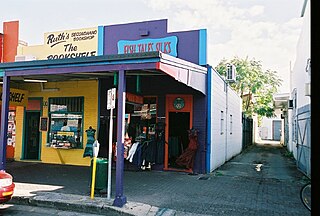
The Cairns Chinatown Building is a heritage-listed commercial building at 99 Grafton Street, Cairns, Cairns Region, Queensland, Australia. It was built from c. 1892 to c. 1902 and is one of the last remaining buildings from the Cairns Chinatown. It was added to the Queensland Heritage Register on 27 May 2005.

Hides Hotel is a heritage-listed hotel at 87 Lake Street, Cairns, Cairns Region, Queensland, Australia. It was designed by Sydenham Stanley Oxenham and built in 1928 by Michael Thomas Garvey. It is also known as Hides Cairns Hotel. It was added to the Queensland Heritage Register on 21 October 1992.

Cairns City Council Chambers is a heritage-listed former town hall and now council library at 151 Abbott Street, Cairns, Cairns Region, Queensland, Australia. It was designed by Hill & Taylor and built from 1929 to 1930 by Alex McKenzie. It was added to the Queensland Heritage Register on 5 October 1998. It is now home to the Cairns City Library.
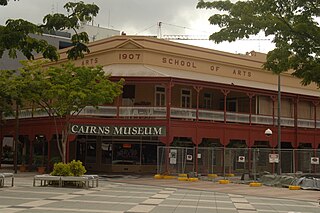
Cairns School of Arts is a heritage-listed former school of arts and now the Cairns Museum at 93-105 Lake Street, Cairns City, Cairns Region, Queensland, Australia. It was designed by Tunbridge, Tunbridge & Lynch and built from 1907 to 1941 by Hanson & Sons. It was added to the Queensland Heritage Register on 21 October 1992.
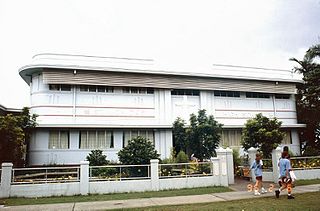
St Monica's High School Administration Building is a heritage-listed private school at Abbott Street, Cairns, Cairns Region, Queensland, Australia. It was designed by Vibert McKirdy Brown and built in 1941 by VW Doyle. It is also known as St Monica's High School. It was added to the Queensland Heritage Register on 1 July 1997.

Mossman District Hospital is a heritage-listed public hospital at Johnston Road, Mossman, Shire of Douglas, Queensland, Australia. It was designed by Hill & Taylor and built c. 1930 by J J Riley. It was added to the Queensland Heritage Register on 12 June 2009.

Springsure Hospital Museum is a heritage-listed former public hospital and now a museum at 13 Woodbine Street, Springsure, Central Highlands Region, Queensland, Australia. It was built from 1868 to 1879. It is also known as Springsure Hospital. It was added to the Queensland Heritage Register on 21 October 1992.

The Second Townsville General Hospital is a heritage-listed former hospital and now an apartment building at 24 Eyre Street, North Ward, Townsville, City of Townsville, Queensland, Australia. It was designed by Donoghue & Fulton and built from 1945 to 1951. It is also known as North Ward Hospital. It was added to the Queensland Heritage Register on 26 April 1996.
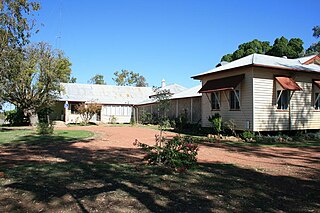
Old Isisford District Hospital is a heritage-listed former public hospital at 6 St Agnes Street, Isisford, Longreach Region, Queensland, Australia. It was designed by Queensland Department of Public Works and built from 1914 to 1918. It is also known as Isisford District Hospital (former). It was added to the Queensland Heritage Register on 9 September 2014.






























